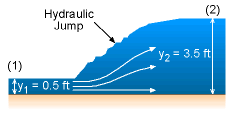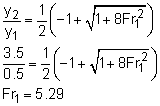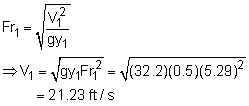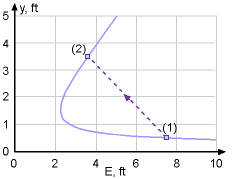| Ch 10. Open-Channel Flow | Multimedia Engineering Fluids | ||||||
|
Uniform Flow |
Gradually Varied Flow |
Rapidly Varied Flow |
|||||
| Rapidly Varied Flow | Case Intro | Theory | Case Solution | Example |
| Chapter |
| 1. Basics |
| 2. Fluid Statics |
| 3. Kinematics |
| 4. Laws (Integral) |
| 5. Laws (Diff.) |
| 6. Modeling/Similitude |
| 7. Inviscid |
| 8. Viscous |
| 9. External Flow |
| 10. Open-Channel |
| Appendix |
| Basic Math |
| Units |
| Basic Fluid Eqs |
| Water/Air Tables |
| Sections |
| eBooks |
| Dynamics |
| Fluids |
| Math |
| Mechanics |
| Statics |
| Thermodynamics |
| ©Kurt Gramoll |
| |
||
|
|
The upstream Froude number (Fr1)
can be determined from the relationship between the upstream and downstream
depths across the hydraulic jump as follows: The continuity equation, Q = V1by1 = V2by2 The downstream Froude number is then calculated to be: |
|
|
The momentum function is defined as M = Q2/gA + zA where A = by and z = y/2 for a rectangular channel, and the volumetric
flow rate Q is determined as follows: The momentum function thus becomes M = Q2/gby + by2/2 The plot of y versus M is given in the specific force diagram. Note that the momentum functions are the same at sections 1 and 2 before and after the hydraulic jump (for a flat-bottomed channel). The specific energy is given by E = y + (1/2g)(Q/by)2 The plot of y versus E is given in the specific energy diagram. The hydraulic jump process is indicated by the dashed line. Note that the specific energy lost across the hydraulic jump equals the change in E between points 1 and 2. It is given by ΔE = E1 - E2 |
|
Practice Homework and Test problems now available in the 'Eng Fluids' mobile app
Includes over 250 free problems with complete detailed solutions.
Available at the Google Play Store and Apple App Store.





